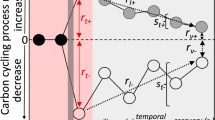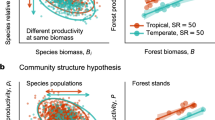Abstract
Canopy structure and tree species diversity, shaped by succession, disturbance, and community composition, are linked to numerous ecosystem functions, including net primary production (NPP). Understanding of how ecosystem structural metrics are interrelated and mechanistically link to NPP, however, is incomplete. We characterized leaf area index (LAI), Simpson’s index of Diversity (D′, a measure of species diversity), and canopy rugosity (Rc, a measure of canopy physical complexity) in 11 forest stands comprising two chronosequences varying in establishing disturbance, and in three late successional communities. We related LAI, D′, and Rc to wood NPP (NPPw), and examined whether absorption of photosynthetically active radiation and light use-efficiency (LUE) link NPPw with ecosystem structure. We found that recovery of LAI and D′ was delayed following more severe establishing disturbances, but that the development of Rc was strikingly conserved regardless of disturbance, converging on a common mean value in late-successional stands irrespective of differences in leaf area index and species diversity. LAI was significantly correlated with NPPw in each stage of ecosystem development, but NPPw was only correlated with Rc in early successional stages and with D′ in late successional stages. Across all stands, NPPw was coupled with LAI and Rc, (but not D′) through positive relationships with light absorption and LUE. We conclude by advocating for better integration of ecological disciplines investigating structure–function interactions, suggesting that improved understanding of such relationships will require ecologists to traverse disciplinary boundaries.





Similar content being viewed by others
References
Anten NPR (2016) Optimization and game theory in canopy models. Canopy Photosynth Basics Appl 42:355–377. https://doi.org/10.1007/978-94-017-7291-4_13
Antonarakis AS, Saatchi SS, Chazdon RL, Moorcroft PR (2011) Using Lidar and Radar measurements to constrain predictions of forest ecosystem structure and function. Ecol Appl 21:1120–1137. https://doi.org/10.1890/10-0274.1
Bond-Lamberty B, Wang CK, Gower ST (2004) Net primary production and net ecosystem production of a boreal black spruce wildfire chronosequence. Glob Change Biol 10:473–487. https://doi.org/10.1111/j.1529-8817.2003.0742.x
Cardinale BJ et al (2011) The functional role of producer diversity in ecosystems. Am J Bot 98:572–592. https://doi.org/10.3732/ajb.1000364
Castro-Izaguirre N et al (2016) Tree diversity enhances stand carbon storage but not leaf area in a subtropical forest. PLoS One. https://doi.org/10.1371/journal.pone.0167771
Chapin FS, Matson P, Mooney HA (2002) Principles of terrestrial ecosystem ecology. Principles of terrestrial ecosystem ecology. pp 436. https://doi.org/10.1007/978-1-4419-9504-9
Chopping M (2011) CANAPI: canopy analysis with panchromatic imagery. Remote Sens Lett 2:21–29. https://doi.org/10.1080/01431161.2010.486805
Danescu A, Albrecht AT, Bauhus J (2016) Structural diversity promotes productivity of mixed, uneven-aged forests in southwestern Germany. Oecologia 182:319–333. https://doi.org/10.1007/s00442-016-3623-4
Drake JE, Davis SC, Raetz LM, DeLucia EH (2011) Mechanisms of age-related changes in forest production: the influence of physiological and successional changes. Glob Change Biol 17:1522–1535. https://doi.org/10.1111/j.1365-2486.2010.02342.x
Dronova I, Bergen KM, Ellsworth DS (2011) Forest canopy properties and variation in aboveground net primary production over upper Great Lakes landscapes. Ecosystems 14:865–879. https://doi.org/10.1007/s10021-011-9451-9
Fahey TJ, Battles JJ, Wilson GF (1998) Responses of early successional northern hardwood forests to changes in nutrient availability. Ecol Monogr 68:183–212. https://doi.org/10.1890/0012-9615(1998)068%5b0183:roesnh%5d2.0.co;2
Fahey RT, Fotis AT, Woods KD (2015) Quantifying canopy complexity and effects on productivity and resilience in late-successional hemlock-hardwood forests. Ecol Appl 25:834–847. https://doi.org/10.1890/14-1012.1.sm
Fahey RT et al (2016) Evaluating forest subcanopy response to moderate severity disturbance and contribution to ecosystem-level productivity and resilience. For Ecol Manag 376:135–147. https://doi.org/10.1016/j.foreco.2016.06.001
Fischer R et al (2016) Lessons learned from applying a forest gap model to understand ecosystem and carbon dynamics of complex tropical forests. Ecol Model 326:124–133. https://doi.org/10.1016/j.ecolmodel.2015.11.018
Forrester DI (2014) A stand-level light interception model for horizontally and vertically heterogeneous canopies. Ecol Model 276:14–22. https://doi.org/10.1016/j.ecolmodel.2013.12.021
Forrester DI, Albrecht AT (2014) Light absorption and light-use efficiency in mixtures of Abies alba and Picea abies along a productivity gradient. For Ecol Manag 328:94–102. https://doi.org/10.1016/j.foreco.2014.05.026
Frelich LE (1995) Old forest in the lake states today and before European settlement. Nat Areas J 15:157–167
Gough CM, Vogel CS, Harrold KH, George K, Curtis PS (2007) The legacy of harvest and fire on ecosystem carbon storage in a north temperate forest. Glob Change Biol 13:1935–1949. https://doi.org/10.1111/j.1365-2486.2007.01406.x
Gough CM, Vogel CS, Hardiman B, Curtis PS (2010) Wood net primary production resilience in an unmanaged forest transitioning from early to middle succession. For Ecol Manag 260:36–41. https://doi.org/10.1016/j.foreco.2010.03.027
Gough CM, Curtis PS, Hardiman BS, Scheuermann CM, Bond-Lamberty B (2016) Disturbance, complexity, and succession of net ecosystem production in North America’s temperate deciduous forests. Ecosphere. https://doi.org/10.1002/ecs2.1375
Hardiman BS, Bohrer G, Gough CM, Vogel CS, Curtis PS (2011) The role of canopy structural complexity in wood net primary production of a maturing northern deciduous forest. Ecology 92:1818–1827. https://doi.org/10.1890/10-2192.1
Hardiman BS, Bohrer G, Gough CM, Curtis PS (2013a) Canopy structural changes following widespread mortality of canopy dominant trees. Forests 4:537–552. https://doi.org/10.3390/f4030537
Hardiman BS et al (2013b) Maintaining high rates of carbon storage in old forests: a mechanism linking canopy structure to forest function. For Ecol Manag 298:111–119. https://doi.org/10.1016/j.foreco.2013.02.031
Hardy JP et al (2004) Solar radiation transmission through conifer canopies. Agric For Meteorol 126:257–270. https://doi.org/10.1016/j.agrformet.2004.06.012
Ishii HT, Tanabe S, Hiura T (2004) Exploring the relationships among canopy structure, stand productivity, and biodiversity of temperature forest ecosystems. For Sci 50:342–355
Johnstone JF et al (2016) Changing disturbance regimes, ecological memory, and forest resilience. Front Ecol Environ 14:369–378. https://doi.org/10.1002/fee.1311
Kashian DM, Turner MG, Romme WH (2005) Variability in leaf area and stemwood increment along a 300-year lodgepole pine chronosequence. Ecosystems 8:48–61. https://doi.org/10.1007/s10021-004-0067-1
Law BE, Sun OJ, Campbell J, Van Tuyl S, Thornton PE (2003) Changes in carbon storage and fluxes in a chronosequence of ponderosa pine. Glob Change Biol 9:510–524. https://doi.org/10.1046/j.1365-2486.2003.00624.x
Li DJ, Waller D (2016) Long-term shifts in the patterns and underlying processes of plant associations in Wisconsin forests. Glob Ecol Biogeogr 25:516–526. https://doi.org/10.1111/geb.12432
Liang JJ et al (2016) Positive biodiversity-productivity relationship predominant in global forests. Science 354:196. https://doi.org/10.1126/science.aaf8957
Medvigy D, Wofsy SC, Munger JW, Hollinger DY, Moorcroft PR (2009) Mechanistic scaling of ecosystem function and dynamics in space and time: ecosystem demography model version 2. J Geophys Res Biogeosci. https://doi.org/10.1029/2008jg000812
Mou P, Fahey TJ, Hughes JW (1993) Effects of soil disturbance on vegetation recovery and nutrient accumulation following whole-tree harvest of a northern hardwood ecosystem. J Appl Ecol 30:661–675. https://doi.org/10.2307/2404245
Musavi T et al (2016) Potential and limitations of inferring ecosystem photosynthetic capacity from leaf functional traits. Ecol Evol 6:7352–7366. https://doi.org/10.1002/ece3.2479
Myneni RB, Williams DL (1994) On the relationship between FAPAR and NDVI. Remote Sens Environ 49:200–211. https://doi.org/10.1016/0034-4257(94)90016-7
Myneni RB, Nemani RR, Running SW (1997) Estimation of global leaf area index and absorbed par using radiative transfer models. IEEE Trans Geosci Remote Sens 35:1380–1393. https://doi.org/10.1109/36.649788
Nakashizuka T (2001) Species coexistence in temperate, mixed deciduous forests. Trends Ecol Evol 16:205–210. https://doi.org/10.1016/s0169-5347(01)02117-6
Nave LE et al (2017) Physiographic factors underlie rates of biomass production during succession in Great Lakes forest landscapes. For Ecol Manag 397:157–173. https://doi.org/10.1016/j.foreco.2017.04.040
Niinemets U (2007) Photosynthesis and resource distribution through plant canopies. Plant Cell Environ 30:1052–1071. https://doi.org/10.1111/j.1365-3040.2007.01683.x
Niinemets U (2016) Within-canopy variations in functional leaf traits: structural, chemical and ecological controls and diversity of responses. In: Hikosaka K, Niinemets U, Anten NPR (eds) Canopy photosynthesis: from basics to applications, vol 42. Springer, Dordrecht, pp 101–141
Niinemets U, Anten NPR (2009) Packing the photosynthetic machinery: from leaf to canopy. Photosynth In Silico Underst Complex Mol Ecosyst 29:363–399
Niinemets U, Keenan TF, Hallik L (2015) A worldwide analysis of within-canopy variations in leaf structural, chemical and physiological traits across plant functional types. New Phytol 205:973–993. https://doi.org/10.1111/nph.13096
Parker GG, Russ ME (2004) The canopy surface and stand development: assessing forest canopy structure and complexity with near-surface altimetry. For Ecol Manag 189:307–315. https://doi.org/10.1016/j.foreco.2003.09.001
Parker GG, Lefsky MA, Harding DJ (2001) Light transmittance in forest canopies determined using airborne laser altimetry and in-canopy quantum measurements. Remote Sens Environ 76:298–309. https://doi.org/10.1016/S0034-4257(00)00211-X
Pedro MS, Rammer W, Seidl R (2015) Tree species diversity mitigates disturbance impacts on the forest carbon cycle. Oecologia 177:619–630. https://doi.org/10.1007/s00442-014-3150-0
Pedro MS, Rammer W, Seidl R (2017) Disentangling the effects of compositional and structural diversity on forest productivity. J Veg Sci 28:649–658. https://doi.org/10.1111/jvs.12505
Pretzsch H, Forrester DL, Rotzer T (2015) Representation of species mixing in forest growth models. A review and perspective. Ecol Model 313:276–292. https://doi.org/10.1016/j.ecolmodel.2015.06.044
Reich PB (2012) Key canopy traits drive forest productivity. Proc R Soc B Biol Sci 279:2128–2134. https://doi.org/10.1098/rspb.2011.2270
Retkute R et al (2015) Exploiting heterogeneous environments: does photosynthetic acclimation optimize carbon gain in fluctuating light? J Exp Bot 66:2437–2447. https://doi.org/10.1093/jxb/erv055
Rohrig M, Stutzel H, Alt C (1999) A three-dimensional approach to modeling light interception in heterogeneous canopies. Agron J 91:1024–1032. https://doi.org/10.2134/agronj1999.9161024x
Spies TA (1998) Forest structure: a key to the ecosystem. Northwest Sci 72:34–39
Stark SC et al (2012) Amazon forest carbon dynamics predicted by profiles of canopy leaf area and light environment. Ecol Lett 15:1406–1414. https://doi.org/10.1111/j.1461-0248.2012.01864.x
Stoy PC et al (2008) Role of vegetation in determining carbon sequestration along ecological succession in the southeastern United States. Glob Change Biol 14:1409–1427. https://doi.org/10.1111/j.1365-2486.2008.01587.x
Stuart-Haentjens EJ, Curtis PS, Fahey RT, Vogel CS, Gough CM (2015) Net primary production of a temperate deciduous forest exhibits a threshold response to increasing disturbance severity. Ecology 96:2478–2487. https://doi.org/10.1890/14-1810.1
Thompson ID et al (2011) Forest biodiversity and the delivery of ecosystem goods and services: translating science into policy. Bioscience 61:972–981. https://doi.org/10.1525/bio.2011.61.12.7
Turner DP et al (2003) A cross-biome comparison of daily light use efficiency for gross primary production. Glob Change Biol 9:383–395. https://doi.org/10.1046/j.1365-2486.2003.00573.x
Vanderwel MC, Zeng HC, Caspersen JP, Kunstler G, Lichstein JW (2016) Demographic controls of aboveground forest biomass across North America. Ecol Lett 19:414–423. https://doi.org/10.1111/ele.12574
Walker LR, Wardle DA, Bardgett RD, Clarkson BD (2010) The use of chronosequences in studies of ecological succession and soil development. J Ecol 98:725–736. https://doi.org/10.1111/j.1365-2745.2010.01664.x
Williams LJ, Paquette A, Cavender-Bares J, Messier C, Reich PB (2017) Spatial complementarity in tree crowns explains overyielding in species mixtures. Nat Ecol Evol. https://doi.org/10.1038/s41559-016-0063
Zha T et al (2009) Carbon sequestration in boreal jack pine stands following harvesting. Glob Change Biol 15:1475–1487. https://doi.org/10.1111/j.1365-2486.2008.01817.x
Zhang J, Hao ZQ, Song B, Li BH, Wang XG, Ye J (2009) Fine-scale species co-occurrence patterns in an old-growth temperate forest. For Ecol Manag 257:2115–2120. https://doi.org/10.1016/j.foreco.2009.02.016
Acknowledgements
We thank two anonymous reviewers and Dr. Jeremy Lichstein, Handling Editor, for their thoughtful assessments of our paper. This study was supported by the National Science Foundation Division of Environmental Biology LTREB Award 1353908, the Division of Atmospheric and Geospace Sciences Award 1262634, and Emerging Frontiers Award 1550650. RTF was supported by United States Department of Agriculture McIntire-Stennis Award CONS00981. We acknowledge the University of Michigan Biological Station for facilities support.
Author information
Authors and Affiliations
Contributions
CMS, LEN, KJN, and CMG conceived and designed the experiments. CMS, LEN, and CMG performed the experiments. CMS, RTF, and CMG analyzed the data. All authors wrote the manuscript and provided editorial advice.
Corresponding author
Additional information
Communicated by Jeremy Lichstein.
Electronic supplementary material
Below is the link to the electronic supplementary material.
Rights and permissions
About this article
Cite this article
Scheuermann, C.M., Nave, L.E., Fahey, R.T. et al. Effects of canopy structure and species diversity on primary production in upper Great Lakes forests. Oecologia 188, 405–415 (2018). https://doi.org/10.1007/s00442-018-4236-x
Received:
Accepted:
Published:
Issue Date:
DOI: https://doi.org/10.1007/s00442-018-4236-x




